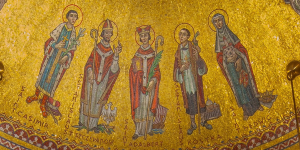
On October 16, the Church observes the feast of Saint Hedwig, Patroness of Silesia. A devoted woman with a compassionate heart, Saint Hedwig used her position in society to improve the lives of others, helping found institutions to support the less fortunate in her community. Today, we invite you to learn about her life, legacy, and where you can find her portrayed at the Basilica.
Early Life and Philanthropy

Born in a castle in the Andechs region in approximately 1174, St. Hedwig was raised as a member of the German nobility. While little is known about her childhood, accounts say that after studying at a monastery, at age 12, she was sent to Poland to wed Henry, Duke of Lower Silesia. Despite her societal advancement, Hedwig continued to live a humble lifestyle, often dressing in second-hand clothing. She kept few personal possessions and was known to eat simple food and read aloud from the Bible at meals.
Over the course of their marriage, Hedwig and Henry had many children, but only two lived to adulthood. Amidst the pain of her loss, Hedwig found solace in her faith. She also took a keen interest in her husband’s governmental affairs and used her position to aid the poor. Together, they founded numerous monasteries, hospitals, and churches, and in 1202, they even used their own land and wealth to establish and endow the first house of religious women in Silesia: the convent of the Cistercian nuns at Trebnitz.
Hedwig and Henry worked together on more than just philanthropic initiatives. Once, when her husband was taken captive after a battle, Hedwig rushed to his side to assist him. Henry’s captor was so amazed at her devotion that he immediately freed the duke. Hedwig was also known for advocating against the death penalty, and often helped soften prisoners’ sentences. Her compassionate care for the lower classes so endeared them to her that, according to one account, “[they] followed her everywhere she went, as if she was their mother.”
Trebnitz and Death
After the birth of their last child, Hedwig and Henry chose to live out the remainder of their union in chastity. It was at this time that Henry earned his nickname “the Bearded,” because he took the tonsure and grew out his facial hair in imitation of the Cistercian lay brothers. Hedwig dedicated her life solely to serving the less fortunate, offering her castle to shelter the homeless and disabled. She also became greatly involved in the work at the Trebnitz convent, where she took permanent residence following Henry’s death in 1238.
For the next five years, she lived as a Cistercian lay sister, but did not take any religious vows so that she could still use her wealth to support a variety of charitable efforts. She also continued to assist the poor and often carried around a small statue of Our Lady which she used to bless those who were ill. Near the end of her life, she spent much of her time in meditation and prayer, and occasionally sought solitude for this task by locking herself in the Abbey chapel overnight. Hedwig passed away at Trebnitz on October 15, 1243, and her daughter Gertrude carried on her legacy of service, later becoming the Abbess of the very convent Hedwig helped found and support.
Saint Hedwig was canonized in 1267 by Pope Clement IV, and is depicted in mosaic tile in the dome of the Our Lady of Czestochowa Chapel.
Sources:
“St. Hedwig,” New Advent.
“St. Hedwig, Duchesse of Polonia, Religious,” Vatican News.
“This princess saint was not Harry Potter’s owl: St. Hedwig of Silesia,” Catholic News Agency.

